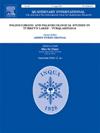Diatom assemblages indicated ecological shifts over the past two centuries in Bosten Lake, northwest China: Natural and anthropogenic forcings
IF 1.9
3区 地球科学
Q3 GEOGRAPHY, PHYSICAL
引用次数: 0
Abstract
Arid Central Asia (ACA), accounting for one-third of the world arid regions, is noted for its sparse freshwater resources and delicate ecosystems. Lakes in this region are sensitive to the complex interactions between climate warming, human impact, and the water cycle, affecting aquatic ecosystems as well as species distributions. Here, we reanalyzed relationships between measured environmental variables and the spatial distribution of 40 previously published lake surface sediment diatom (Bacillariophyceae) assemblages along with synthesized sediment cores from 4 distinct locations in Bosten Lake with the intention of developing a diatom-inference model for water depth. Diatom assemblage variations differed across surface sediment samples and within cores in Bosten Lake. The initial period (1770–1910 CE) is characterized by oligotrophic taxa such as Lindavia radiosa and Navicula peroblonga, which transitioned towards meso-eutrophic species such as Pseudostaurosira, Staurosira, and Staurosirella spp. (formerly classified in the genus Fragilaria) during 1910–1960 CE and notably lake became more eutrophic post-1960, marked by the abundance of Fragilaria cf. crotonensis. Redundancy analysis (RDA) showed that lake water depth explained a statistically significant portion of diatom assemblage variations. Weighted-averaging partial least squares (WA-PLS) is used to develop a diatom-based depth inference model ( = 0.94, RMSEP = 1.08 m, and maximum bias = 2.57 m) based on diatom optima from Bosten Lake. Diatom-depth reconstructions and changes in diatom community composition are of great importance to track lake ecosystem dynamics, ensuring the sustainability of vital freshwater resources in the ACA and beyond.

博斯腾湖硅藻群落反映了过去两个世纪的生态变迁:自然和人为强迫
中亚干旱地区占世界干旱地区的三分之一,淡水资源稀少,生态系统脆弱。该地区湖泊对气候变暖、人类活动和水循环之间复杂的相互作用非常敏感,影响着水生生态系统和物种分布。在此,我们重新分析了40个先前发表的湖表面沉积物硅藻(硅藻科)组合的空间分布与测量的环境变量之间的关系,以及来自Bosten湖4个不同地点的合成沉积物岩心,旨在建立一个硅藻深度推断模型。博斯腾湖表层沉积物样品和岩心内硅藻组合的变化存在差异。初期(公元1770-1910年)以少营养类群如Lindavia radiosa和Navicula peroblonga为特征,在公元1910-1960年期间向中营养类群过渡,如Pseudostaurosira, Staurosira和staurosiella spp.(以前归为Fragilaria属),特别是1960年后湖泊变得更加富营养化,以Fragilaria cf. crotonensis丰富为标志。冗余分析(RDA)表明,湖泊水深解释了硅藻组合变化的统计显著部分。利用加权平均偏最小二乘法(WA-PLS)建立了基于Bosten湖最优硅藻的深度推断模型(Rjack2 = 0.94, RMSEP = 1.08 m,最大偏差= 2.57 m)。硅藻深度重建和硅藻群落组成变化对跟踪湖泊生态系统动态,确保重要淡水资源的可持续性具有重要意义。
本文章由计算机程序翻译,如有差异,请以英文原文为准。
求助全文
约1分钟内获得全文
求助全文
来源期刊

Quaternary International
地学-地球科学综合
CiteScore
5.60
自引率
4.50%
发文量
336
审稿时长
3 months
期刊介绍:
Quaternary International is the official journal of the International Union for Quaternary Research. The objectives are to publish a high quality scientific journal under the auspices of the premier Quaternary association that reflects the interdisciplinary nature of INQUA and records recent advances in Quaternary science that appeal to a wide audience.
This series will encompass all the full spectrum of the physical and natural sciences that are commonly employed in solving Quaternary problems. The policy is to publish peer refereed collected research papers from symposia, workshops and meetings sponsored by INQUA. In addition, other organizations may request publication of their collected works pertaining to the Quaternary.
 求助内容:
求助内容: 应助结果提醒方式:
应助结果提醒方式:


